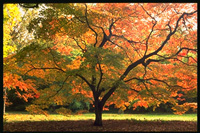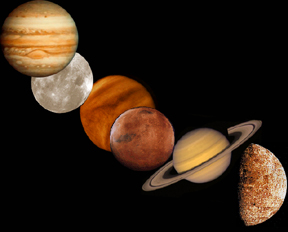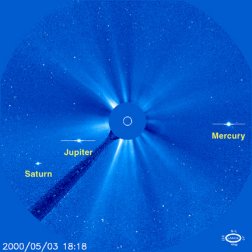This is the latest image from SOHO. The disc in the middle is blocking out the Sun. The lines on the planets are not rings!
Click on image for full size
Courtesy of NASA
SOHO Catches Planetary Alignment
News story originally written on May 10, 2000
The Solar and Heliospheric Observatory (SOHO) will give us a special treat
this month. On May 15, it will capture Mercury, Venus, Jupiter and Saturn
together in what scientists call a conjunction. They will all be on the opposite
side of the Sun.
You can watch the show on both the internet and NASA TV. The original
show was on May 5, but NASA will have updated videos on May 12, and May 15.
If you'd rather not wait until then, the SOHO
Home Page has some images.
You might also be interested in:

It was another exciting and frustrating year for the space science program. It seemed that every step forward led to one backwards. Either way, NASA led the way to a great century of discovery. Unfortunately,
...more
The Space Shuttle Discovery lifted off from Kennedy Space Center at 2:19 p.m. EST, October 29th. The sky was clear and the weather was great as Discovery took 8 1/2 minutes to reach orbit for the Unitied
...more
A moon was discovered orbiting the asteroid, Eugenia. This is only the second time in history that a satellite has been seen circling an asteroid. A special mirror allowed scientists to find the moon
...more
Will Russia ever put the service module for the International Space Station in space? NASA officials are demanding an answer from the Russian government. The necessary service module is currently waiting
...more
During a period of about two days in early May, 1998, the ACE spacecraft was immersed in plasma associated with a coronal mass ejection (CME). The SWICS instrument on ACE, which determines unambiguously
...more
J.S. Maini of the Canadian Forest Service has referred to forests as the "heart and lungs of the world." Forests reduce soil erosion, maintain water quality, contribute to atmospheric humidity and cloud
...more
In late April through mid-May 2002, all five naked-eye planets are visible simultaneously in the night sky! This is includes Mercury which is generally very hard to see because of its proximity to the
...more















